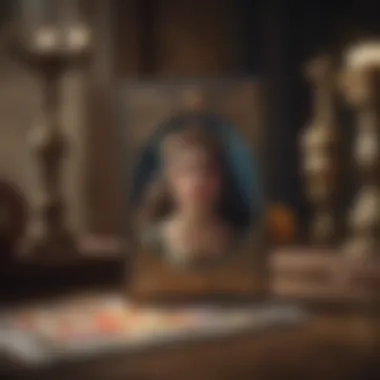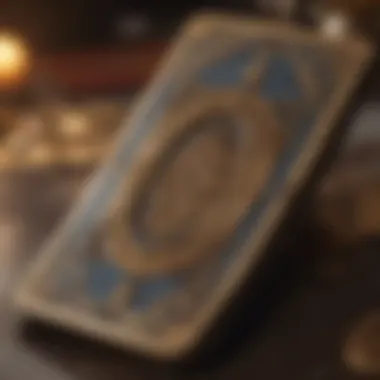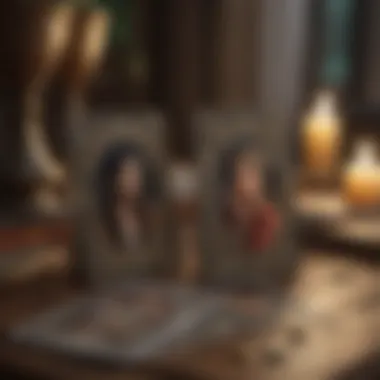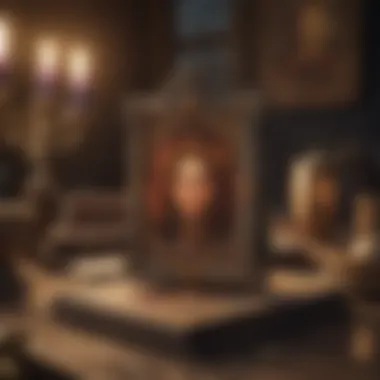A Comprehensive Guide to Choosing Tarot Cards


Intro
Choosing the right tarot cards is not merely about picking a deck that looks appealing. It goes deeper, involving a thorough understanding of personal preferences, various deck types, and individual beliefs. The richness of symbolism inherent in tarot cards adds layers of meaning to one’s readings. Thus, this guide serves as a comprehensive resource for those seeking to navigate the intricate process of selecting tarot cards that resonate with their life and spiritual journey.
Aesthetic Appeal
When choosing tarot cards, one must first consider the visual aspects of a deck. The artwork often serves as the initial connection, influencing users' inclination towards specific cards. Different decks present unique styles, from traditional imagery like the Rider-Waite-Smith to more modern representations such as the Wild Unknown. Analyze how colors, illustrations, and overall aesthetics align with personal taste. A deck that resonates visually encourages more profound engagement and facilitates a smoother reading experience.
Symbolism and Meanings
Symbolism plays a crucial role in tarot. Each card carries its distinct essence and can significantly impact interpretations during readings. Review the imagery on the cards and understand what each symbolizes. For instance, The Fool signifies new beginnings, while The Tower indicates sudden change. Ensuring familiarity with card meanings can aid in connecting more deeply with the messages the cards convey. Selecting a deck you can relate to will enhance your intuition and readings well.
Emotional Connection
The emotional aspect cannot be overlooked in the selection process. A strong bond between the user and the deck can greatly influence the effectiveness of the reading. Pay attention to how you feel when handling different decks. Some individuals may find certain cards comforting, while others may evoke fear or discomfort. It is essential to find a balance that promotes a positive reading atmosphere.
Finding your tarot deck is like discovering an old friend; you should feel a sense of comfort and familiarity.
Practical Considerations
Beyond aesthetics and emotional resonance, practical considerations also come into play. Some aspects can't be ignored:
- Usability: How the cards shuffle and feel in your hands matters. A deck that slips and shuffles easily can enhance the reading experience.
- Size and Format: Different decks have varying sizes. Larger cards might be cumbersome for daily use, while mini decks can be more portable but harder to read.
- Manufacturing Quality: Consider the quality of cards. Thicker, coated cards tend to last longer compared to thinner ones that might wear out quickly.
Intuition and Personal Preference
Finally, remember that intuition should guide your choice. Spend time with potential decks in a calm setting; meditate on which resonates the most. Pay attention to any gut feelings or insights that arise. No two tarot readers are identical; what works for one may not for another. Embrace your unique connection to the cards.
By examining these facets with care, you will be empowered to select tarot cards that align with your spiritual beliefs and reading style, paving the way for a richer tarot exploration.
Understanding Tarot Cards
Understanding tarot cards is crucial for anyone seeking to dive into this intricate world of symbolism and insight. The right deck can enhance one's readings, leading to deeper self-awareness and clarity in interpretations. A nuanced understanding of tarot cards involves more than just choosing pretty imagery; it demands a recognition of the components that make up a deck and the meanings imbued in each card. This section outlines the essential characteristics of tarot cards, their structure, and the symbolism they carry.
Definition and Purpose
Tarot cards are a collection of cards, typically 78 in total, used for divination and self-reflection. Their purpose extends beyond mere fortune-telling; they serve as tools to tap into one's intuition and subconscious mind. The experience of using tarot cards varies widely from person to person. The effectiveness of a tarot reading depends on both the deck and the reader's connection to it. By understanding what tarot cards are and their intended use, individuals can approach them with a more informed mindset.
The Structure of a Tarot Deck
A standard tarot deck consists of two main parts: the Major Arcana and the Minor Arcana. Each section serves a unique purpose and offers different insights.
Major Arcana
The Major Arcana contains 22 cards that depict significant life themes and experiences. Each card carries profound meanings, often reflecting powerful archetypes and transformative journeys. The key characteristic of the Major Arcana is its ability to represent major life changes, spiritual lessons, and deep psychological insights. This right choice is beneficial for those who seek to explore more serious aspects of their life’s journey. The unique feature of the Major Arcana is that each card stands alone with rich symbolism; while its interpretations can vary, its representation of pivotal moments is consistent.
Minor Arcana
Contrasting the Major Arcana, the Minor Arcana consists of 56 cards divided into four suits: Cups, Pentacles, Swords, and Wands. These cards deal with daily events and experiences, providing a more nuanced view of everyday life. The key characteristic of the Minor Arcana is its focus on the mundane, which can highlight both challenges and joys in daily living. For many tarot users, Minor Arcana cards are essential for practical insights. Their unique feature lies in the detailed nuances they convey, often linking broader themes from the Major Arcana to specific situations in one’s life. While they may not carry the same weight as the Major Arcana, they are valuable for understanding current circumstances and short-term influences.
Symbolism in Tarot


The symbolism found in tarot cards is a vast and complex landscape. Each card is imbued with layers of meaning that can be interpreted through various lenses, such as numerology, astrology, and element association. The colors, images, and even the card layout all play critical roles in the readings. A comprehensive understanding of symbolism allows the reader to become more attuned to the subtle messages each card conveys. Often, these symbols resonate deeply, prompting personal reflections and insights that go beyond the obvious meanings. By exploring symbolism, one can unlock deeper understanding in their tarot readings, forging a stronger connection with the cards.
Exploring Different Types of Tarot Decks
Understanding the various types of tarot decks is crucial when selecting the right cards for your practice. Each deck offers unique aesthetics, symbolism, and energy. By exploring different types of tarot decks, both novices and practiced readers can find cards that resonate with their personal journey. This knowledge can enhance the overall experience and effectiveness of tarot readings.
Traditional Decks
Traditional tarot decks typically follow the classic Rider-Waite-Smith structure. These decks consist of 78 cards, divided into Major and Minor Arcana. The artwork in traditional decks might seem less varied, but they offer firm grounding in the foundational meanings of tarot. These decks often appeal to those who seek a connection to the historical elements of tarot reading.
Benefits of Traditional Decks:
- Familiar themes and imagery make it easier for beginners.
- Strong emphasis on established symbolism.
- Insight into historical practices and interpretation methods.
Modern and Themed Decks
Modern and themed decks have gained popularity in recent years. These decks often incorporate contemporary art styles and unique themes that appeal to personal tastes. Themes can range from fantasy and nature to pop culture. Choosing a modern deck allows readers to explore tarot through a lens that feels relevant to them.
Considerations for Modern Decks:
- Diverse art styles can make readings more enjoyable.
- Reflects current cultural trends, possibly enhancing relatability.
- Creative interpretations can offer fresh insight into traditional meanings.
Oracle and Specialty Decks
Oracle decks differ from tarot in structure and purpose, providing a more flexible approach to inspiration and guidance. They can come in various forms, each with different numbers of cards and themes, often focusing on specific topics like self-care, healing, or mindfulness. Specialty decks, conversely, may align closely with personal interests or artistic styles.
Features of Oracle and Specialty Decks:
- No fixed structure allows for a wide range of imagery and messages.
- Great for those who wish to explore beyond the tarot framework.
- Can be combined with tarot for enhanced readings, offering additional perspectives.
People new to tarot should consider trying various kinds of decks. Each type has distinct offerings that can elevate their experience.
Whether one is drawn to the traditional, modern, or oracle decks, the range provides numerous choices to explore. Understanding these varieties aids in making informed selections that enhance personal connection and understanding of tarot. This exploration remains a vital element in the journey toward effective tarot reading.
Factors to Consider When Choosing Tarot Cards
Choosing the right tarot cards involves several thoughtful considerations. Understanding what factors matter can lead to a more fulfilling tarot experience. Each element plays a key role in establishing a connection with the cards, enhancing the reading process. Recognizing these factors enables both novices and seasoned users to make informed choices aligning with their personal spiritual journeys.
Personal Aesthetics and Preferences
Art Style
Art Style is crucial when selecting tarot cards. The visual representation on the cards can significantly impact one's connection to the deck. Diverse styles exist, from the intricate illustrations of the Rider-Waite deck to the minimalist designs found in modern decks. A deck with an appealing art style can evoke emotional responses and cultivate deeper insights during readings. For example, whimsical art may resonate with those approaching tarot playfully, while more serious styles may appeal to users seeking solemn reflection.
Color Palette
Color Palette is another significant aspect. Colors can create moods and influence feelings during readings. A harmonious palette can enhance relaxation and focus. Bright colors often reflect positive energies, while darker shades may provide a more introspective atmosphere. Choosing a color palette that resonates with personal feelings can foster a stronger relationship with the deck. For instance, someone drawn to earthy tones might find comfort and stability in those hues, enhancing their connection with the cards.
Symbolic Resonance
Symbolic Resonance speaks to how well the symbols on the cards align with a reader's personal beliefs and experiences. Each tarot card carries layered meanings and interpretations. Users should seek decks with symbols that resonate strongly. A deck that reflects personal struggles or triumphs could provide more insightful readings. It is essential to explore how these symbols make one feel to ensure they hold significance.
Card Usability


Size and Texture
Size and Texture contribute significantly to the tactile experience of tarot reading. A comfortable size ensures ease of handling; larger cards may be visually satisfying but difficult to shuffle. Conversely, smaller cards are more portable but may lack dramatic presence. Texture also matters; smooth cards could glide effortlessly but may feel impersonal. A textured finish can provide a better grip, enhancing the enjoyment of shuffling. Users should choose based on what feels right for them.
Ease of Shuffling
Ease of Shuffling is vital for users who emphasize the physical aspect of tarot readings. Cards that shuffle smoothly can create a more pleasant and less stressful experience. Some decks might be too stiff or rigid, making them challenging to work with. Ensuring that the cards move well in the hands can enhance the feeling of connection and fluidity during readings.
Intuitive Connection to the Deck
Intuitive Connection to the Deck is often overlooked but incredibly important. This connection refers to the innate feeling one has when holding or looking at the deck. Some users instinctively know a deck is right for them upon sight or touch. Trusting this feeling is essential because it can dictate the effectiveness of readings. A strong intuitive connection often leads to deeper understanding and more meaningful interpretations, solidifying the relationship between reader and cards.
Finding Resources for Selecting Tarot Cards
Understanding how to select tarot cards involves significant research and exploration. Resources available can provide guidance and insight. They help both beginners and seasoned readers in navigating the vast world of tarot. Many options exist for gathering information. The best approach combines exploring multiple resources.
Books and Guides
Books and guides serve as fundamental tools for anyone interested in tarot. They offer structured knowledge on card meanings, spreads, and interpretation techniques. A well-rounded collection can include foundational texts by well-known authors such as Rachel Pollack, who provides depth into tarot's history and symbolism.
Furthermore, specific guides can assist you in understanding various deck types. Some books even focus solely on interpretations related to particular decks. This tailored approach can significatly enhance your connection to the chosen cards.
Some recommended titles:
- "78 Degrees of Wisdom" by Rachel Pollack
- "The Tarot Bible" by Sarah Bartlett
- "The Ultimate Guide to Tarot" by Liz Dean
These resources not only expand your knowledge but also clarify any confusion about tarot practices.
Online Communities and Reviews
Engaging with online communities is a potent way to learn about tarot cards. Platforms like Reddit or Facebook host various groups where users share insights and experiences. Community discussions often bring fresh perspectives that books may not provide.
Reviews of specific decks can also be found on these platforms. Such reviews range from aesthetic preferences to practical usability. Readers can gain insights on how decks perform in readings and the emotional responses they evoke.
Additionally, user-generated content, including blogs or vlogs, can highlight unique aspects of different decks. Personalized stories can create an emotional link with potential choices.
Workshops and Classes
Participation in workshops or classes is beneficial for hands-on learning. Many experienced tarot practitioners offer workshops focusing on specific topics. These can include basic reading skills, advanced techniques, or even deck-specific practices. Many local metaphysical shops also provide these classes.
Workshops allow interaction with other learners and teachers. This dynamic can aid in building a community around tarot reading, which is vital for ongoing growth. Often, workshops even provide opportunities to handle various decks. This direct experience can facilitate a better understanding of each deck's energy and usability.
In summary, finding resources for selecting tarot cards is essential. It encourages informed choices, supports personal growth, and fosters connections within the tarot community. The selection process should involve careful consideration of available resources, blending studies from print materials and online discussions while participating in practical experiences.
Practical Tips for Choosing Tarot Cards
Choosing tarot cards involves personal feelings and practical considerations. These tips aim to clarify that process, helping you find a deck that resonates with your inner self. Taking time to reflect on your choices can lead to a more satisfying connection with your cards.
Handling Multiple Decks
Many tarot enthusiasts choose to work with multiple decks. This can enrich your reading experience as different decks bring various perspectives. When managing several decks, organization is key. Keep them in a designated space to avoid misplacing cards. Each deck may represent a distinct aspect of your life or intuition. Consider creating a catalog to note the themes and unique features of each deck. Doing this allows you to switch based on what you need or feel at a certain time. It can also help in comparing and contrasting different decks as you grow in your practice.


Trial and Error Approach
Engaging in a trial-and-error method can be beneficial in selecting tarot cards. Experimentation allows you to explore different styles without the pressure of fully committing. It is useful for discovering what truly resonates with you. Start by borrowing decks from friends or fellow practitioners, or even visit local shops that offer deck testing. Using various decks can help you understand your reading style and preferences better. Documenting your experiences with each deck can provide insight into what elements you value most. This method instills confidence in your final choice, ensuring a deeper connection with the cards you ultimately select.
Personal Rituals and Cleansing Techniques
Integrating personal rituals into your tarot practice can enhance your relationship with your deck. Cleansing techniques play a vital role in refreshing the energy of your cards. After acquiring a new deck, consider methods like smoke cleansing using sage or incense, or placing the cards under moonlight. These practices help you set your intentions and clear any residual energy. Rituals can also include meditation or visualization exercises to align the deck’s energy with your own. Develop a consistent routine that feels right for you. This can deepen your connection and efficiency in readings, generating clarity and focus.
By embracing these practical tips, you can create a solid foundation for your tarot journey. Understanding how to handle multiple decks, adopting a trial-and-error approach, and integrating personal rituals will enhance your skills. Ultimately, these steps will lead to a rewarding and personal tarot experience.
Understanding the Mood and Energy of Your Deck
Selecting a tarot deck is more than just a choice of imagery or style; it involves an understanding of the mood and energy that a deck carries. This aspect is crucial as it affects how you resonate with the cards during readings. Every deck has its own personality, formed by the artistic choices of the creators, the symbolism embedded within, and the energies that the cards embody. The emotional connection between you and your deck can significantly influence the clarity and potency of your tarot readings.
Connecting with Your Deck
When you first receive or choose a tarot deck, take time to connect with it. This can be accomplished by simply handling the cards, observing their imagery, and noting your immediate emotional response. Do the colors inspire tranquility, or do they evoke a sense of unease? Each card offers a unique energy, and your intuition can guide you toward understanding this mood.
You might consider spreading out the cards and selecting a few at random. Reflect on what these specific cards mean to you at that moment. This process can help build a bond with your deck. Spending time with the deck, perhaps through daily draws or meditative practices, further establishes a connection that enhances your readings. Creating a safe space for these interactions will further deepen your relationship with the cards.
The Role of Intention in Card Selection
Intention plays a key role in selecting the right tarot deck. What are you seeking to achieve through your readings? By clearly defining your intention, you can choose a deck that aligns with your spiritual goals. Intentions might vary, such as seeking clarity in personal issues, understanding emotional dynamics, or exploring future potentials.
Before acquiring a deck, contemplate how it may serve your purpose. For instance, if you are drawn to mystical themes, a deck like the Wild Unknown Tarot featuring animal imagery might resonate well with your exploratory intent. Whatever your focus is, the intention behind your selection can make a substantial impact on your readings.
Incorporating this understanding into your tarot practice allows for a more enriching experience. Once you are aware of your intentions, trust that your choice is aligned with your spiritual journey.
"The tarot is a reflection of your inner self, and its energy can either uplift or hinder your journey, depending on your choice."
Recognizing the mood and energy of your chosen deck not only enhances your connection with the cards but also enriches your overall tarot experience.
Epilogue
Choosing the right tarot cards is a fundamental aspect of your tarot practice. It impacts how you interpret the cards and connect with the readings. This article emphasizes several key elements to keep in mind when selecting a tarot deck. Understanding personal aesthetics can help in identifying which art styles resonate with you. This connection makes tarot an expression of your own spiritual journey.
Another essential consideration is symbolism. Each card holds a unique meaning that intertwines with your intuition. Recognizing these symbols can deepen your understanding of your readings, providing you with richer insights.
It is also crucial to reflect on usability. A deck that feels comfortable in your hands aids in smoother readings and in building a deeper connection with your cards. Not only does practical usability enhance your experience, but it also supports effective shuffling and handling.
By focusing on these elements—personal aesthetics, symbolism, and usability—you can choose tarot cards that enhance your practice. This careful selection process leads to more meaningful readings and a greater spiritual journey.
Summarizing Key Takeaways
In summary, selecting tarot cards involves more than just picking a deck that looks appealing. Here are the key takeaways from this article:
- Art Style: Choose a design that resonates with your personal preference.
- Color Palette: Consider colors that evoke specific emotions for you.
- Symbolic Resonance: Identify symbols that align with your intuition and spiritual beliefs.
- Card Usability: Ensure the deck feels comfortable in your hands and is easy to shuffle.
- Intuitive Connection: Trust your instincts when connecting with a deck—this can lead to a strong emotional bond.
These takeaways serve as a foundation for a more enriched tarot reading experience. Make yourself familiar with these concepts as you interact with different decks.
Encouragement to Explore Personal Connection
As you embark on your tarot journey, remember that the bond between you and your tarot cards is unique. It is essential to prioritize your personal connection to the deck you choose. Don’t hesitate to explore various decks until you find one that feels right.
Consider participating in online communities, such as those on reddit.com, to share your experiences and gather opinions on different decks. Your exploration may lead to discovering lesser-known decks that resonate deeply with you.
Take part in workshops or classes to gain insights into how others connect with their decks. Learning from different perspectives can strengthen your own practice. Ultimately, the most important part is finding a deck that speaks to you—one that harmonizes with your individual energy and beliefs.
Choosing tarot cards is not simply a task; it is a personal journey. Engage deeply with this process to unlock the potential of your readings.







